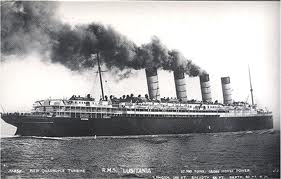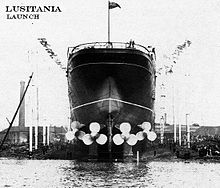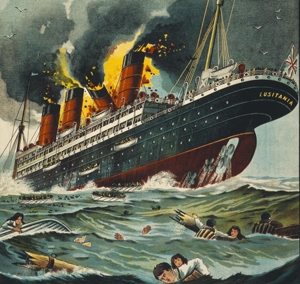 The Lusitania was a passenger ship running between the US and Great Britain during and before WWI. She was renowned for both her speed and luxury, but came to an ill fate when she was torpedoed by a German uboat in the early summer of 1915, with great loss of life.
The Lusitania was a passenger ship running between the US and Great Britain during and before WWI. She was renowned for both her speed and luxury, but came to an ill fate when she was torpedoed by a German uboat in the early summer of 1915, with great loss of life.
The Lusitania and Titanic: Style and Speed In Common
The Lusitania, at its time, was (albeit briefly) the world’s largest ship at 787 feet (the Titanic was the largest when it was built, at 882 ft 6 inches!).
Like the Titanic, she was also built for world-class speed (her cruising speed was 25 knots; the Titanic’s was 21 knots), and she actually earned the coveted Blue Riband record for fastest travel time across the Atlantic, 4 times back to back (from 1907 to 1909, twice in 1908).
Importantly, at the time of their respective launches, both ships had what were considered the most luxurious interiors the world had ever seen on large passenger ships.
Trivia: The ship’s name came from an ancient Roman region located in the modern day country of Portugal.
Background on Design and Construction
 The Cunard line faced stiff competition from the White Star Line. White Star was backed by JP Morgan through his holding company IMM, and was of course the shipping company that built the Titanic and her sister ships. Cunard had made its reputation in developing the fastest liners in the world, whereas White Star chose to focus more on luxury and sheer size.
The Cunard line faced stiff competition from the White Star Line. White Star was backed by JP Morgan through his holding company IMM, and was of course the shipping company that built the Titanic and her sister ships. Cunard had made its reputation in developing the fastest liners in the world, whereas White Star chose to focus more on luxury and sheer size.
This led to Cunar obtaining a loan from the British government for the financing of the Lusitania in 1903, and work on the design began in earnest in 1904.
In line with Cunard’s strong focus on speed (a key factor in reducing long trans-atlantic travel times), the designers enlisted the engineering services of Parsons Marine, a company developing cutting edge turbine technology.
The hull area contained 12 separate water-tight compartments. Up to 2 of these compartments could be breached and the ship would not sink (in contrast, the Titanic had 16 major watertight compartments, and could generally remain afloat with any 3 compartments flooded, with a couple of exceptions). Water-tight doors were used to separate the various compartments. One key flaw in this design was that sliding doors used to provide coal to the engines needed to be open in order to run the ship, and closing the water-tight doors would prevent this.
Prior to the Lusitania, it was common practice for 3rd class passengers to all be housed in large open spaces, a very uncomfortable way to travel. Lusitania was the first to actually introduce quarters for their 3rd class customers. Cabins were either two, four, six or eight berth layouts, and represented a significant upgrade from what customers were used to. Additionally, the Lusitania provided 50% more passenger space than any other ship at that time.
The Sinking of the Lusitania
 At the onset of WWI, she was initially commandeered as an armed merchant cruiser, but the British royalty instead allowed her to resume passenger transport under the condition she also ship government goods.
At the onset of WWI, she was initially commandeered as an armed merchant cruiser, but the British royalty instead allowed her to resume passenger transport under the condition she also ship government goods.
On May 1, 1915 she set sail from New York to Liverpool. Already 1 year into WWI, the Germans had declared a war zone in the seas around England, and the German Embassy in the US had warned passengers not to travel on the Lusitania.
On May 7, with the Lusitania only 11 miles off the coast of Ireland, she was torpedoed by the German Uboat. She sank in 18 minutes, with 1,198 lives lost, and 764 survivors.
While it is true that the Lusitania was transporting military cargo, including ammunition, in contradiction to the current maritime laws at the time, nevertheless the sinking caused a tremendous uproar in the US, and was one of the key factors leading the US to join WWI.
Even After the Titanic, Lifeboat Problems Persisted
Like the ill-fated Titanic, the Lusitania also did not carry a sufficient number of wooden lifeboats. She actually had a total of 48 lifeboats on board (more than enough for her 1,959 passengers and crew), but more than half of those required some assembly.
With the Lusitania sinking so quickly (and with the ensuing chaos on board after being hit by a torpedo), there simply wasn’t any time to assemble many of these boats.
To compound matters, she began to list starboard severely almost immediately after being hit, making a further number of wooden lifeboats undeployable. In total, only 6 of the lifeboats were successfully launched.
The Sinking From the POV Of the German Uboat
 The Lusitania was hit by a single torpedo fired from the German uboat U-20, led by Captain Walther Schwieger. Just off the coast of Ireland, at 1:40PM on May 7, 1915, he spotted the Lusitania through his periscope, and ordered a single torpedo fired. The torpedo found its mark directly below the bridge of the Lusitania, but to Schwieger’s surprise, there was a second, much more powerful explosion (perhaps from munitions on board the Lusitania, or maybe a boiler exploding).
The Lusitania was hit by a single torpedo fired from the German uboat U-20, led by Captain Walther Schwieger. Just off the coast of Ireland, at 1:40PM on May 7, 1915, he spotted the Lusitania through his periscope, and ordered a single torpedo fired. The torpedo found its mark directly below the bridge of the Lusitania, but to Schwieger’s surprise, there was a second, much more powerful explosion (perhaps from munitions on board the Lusitania, or maybe a boiler exploding).
Fifteen minutes after firing the first torpedo, Schwieger penned in his diary “It looks as if the ship will stay afloat only for a very short time…I couldn’t have fired another torpedo into this mass of humans desperately trying to save themselves…”
Trivia: the U20 sank a total of 36 ships totaling more than 140,000 tons. On November 4, 1916, she ran aground on the Danish coast and was scuttled by her crew.
Lusitania Conspiracy Theories
While the majority of passengers were British, there were 139 Americans on board as well, of which 128 perished. There has been a persistent theory that the British government actually wanted the Lusitania to get attacked by the Germans in order to draw the US into the war. Questions include:
- With the British aware of the German uboat danger in the specific waters the Lusitania was traveling, why did they not divert its course?
- Why was the Lusitania not given a standard destroyer escort, despite such ships being available in nearby ports?
- Why was the Lusitania ordered to reduce her speed in the war zone, for reasons that have never been publicly disclosed?
Interestingly, in February 2009, the show “Treasure Quest” (Discovery Channel) aired an episode on the Lusitania. A team of expert divers explored the wreck with remote control devices, and at one point discover an exploded depth charge. The question has naturally arised: “What is the British government trying to hide?”
To me, one of the more damning pieces of evidence that there might actually have been a conspiracy was a note that Winston Churchill wrote to a maritime government official 1 week prior to the sinking of the Lusitania: “…[it is] most important to attract neutral shipping to our shores, in the hope especially of embroiling the United States with Germany.”

